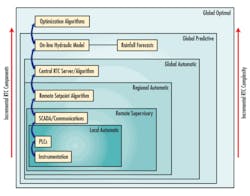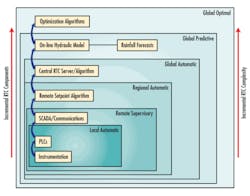Real-Time Control to Reduce Combined Sewer Overflows
By Srini Vallabhaneni and Eddie Speer
Urban drainage systems are typically designed and built in segments over long periods of time, often leading to circumstances where portions of a system may be underutilized, while other areas are overtaxed during storm events, contributing to sewer overflows. In an effort to reduce the cost of capital infrastructure associated with correcting these issues, utilities are transitioning from passive operation of these systems to active control, using pumps, gates, and inflatable dams. "Real-time control" (RTC) is often used to describe the portfolio of technologies required to implement this attractive alternative.
Combined sewer systems are commonly found in older urban areas, where drainage issues were being addressed prior to the advances in treatment technology and the focus on water quality that occurred during the mid-20th century. Because these systems use a single-pipe network to collect municipal wastewater and storm runoff, the sewer trunks can become quite large to accommodate the potential flows. However, in large networks, the capacities in these large conduits are not frequently used uniformly during a storm event, leading to circumstances where combined sewer overflows (CSOs) are occurring in one area while capacity exists nearby.
The financial resources to accomplish CSO control goals in addition to routine sewer system improvements and management functions are paramount. Utility managers are exploring real-time control opportunities to reduce overall program cost by maximizing the existing system usage through efficient operation and optimizing the size of future improvements.
RTC enables combined sewer collection systems to capture increased wet weather flow by: (1) maximizing the use of available in-system storage, (2) maximizing available system conveyance capacity by diverting flow dynamically and (3) enhancing control logic for off-line storage/lift stations.
- In-system storage using gates or similar devices reduces conveyance to combined sewer overflow locations during wet weather and allows flow to back up into and be stored within the otherwise unoccupied portions of the combined sewer pipe.
- Dynamic flow diversion (or flow shunting) enables the system's hydraulic conveyance capacity to be more fully utilized during wet weather by shifting flows from overloaded interceptors to those with capacity using pinch valves or similar devices.
- Enhanced control logic at off-line flow equalization facilities/large lift stations allows storage volumes, as well as influent and release rates to be adjusted based on hydraulic conditions at critical locations along interceptor sewers.
RTC Strategies
Typically, a hydraulic simulation model of the sewer system is used to simulate various real-time control strategies and alternatives to determine which approach or combination of approaches are most beneficial for system performance improvements.
An RTC strategy can be developed for controlling a single device (locally) or can be developed for controlling many elements throughout the system (globally). Full descriptions of the various levels of RTC are comprehensively described by Vallabhaneni et al. (WEF, Collection System 2010). The complexity and extent of component technologies required to implement the strategy will vary based on the scope of the strategy. Not all collection systems will benefit from the most complex implementation, depending on requirements, organizational structure, and physical aspects of the collection system.
For all RTC strategies, common elements include:
- Flow or level measurements, including associated instrumentation.
- Control elements (typically a gate, valve, movable dam, or pump), including associated electronic controls.
- An algorithm that describes how control elements behave.
- Human operators.
Additional elements may be present, depending on the complexity of the application. For example, in a highly complex RTC system with global predictive controls, rainfall measurements are often used in real time to calculate future storm flows entering the collection system.
Guiding Principles
The following six guiding principles should be considered in establishing an RTC strategy for a typical municipal utility:
1. RTC should be based first and foremost on business needs-what does the owner/operator need to accomplish-and not on preconceived choices of technology. Business needs come first and technology choices must address those needs.
2. RTC development methodologies should lead to cost-effective solutions. Start simple and then move toward more complex RTC measures, if appropriate. A complex approach may be shown theoretically to perform at higher levels. However, a phased approach-building incrementally upon what has already been done successfully-has a higher chance of success and is easier to manage.
3. RTC implementation methodology should minimize risk. The specific measures of success for RTC projects should be identified early, tracked closely and documented well to determine whether expected RTC benefits are realized once the system is in operation.
4. The success of RTC projects depends on active participation of stakeholders from inception through implementation. A structured process should be in place for achieving system acceptance by users. Inclusion of operations and maintenance staff is critical at early stages and throughout implementation.
5. RTC technology should be easy to maintain and support in the future, with a clear path to enhancements and upgrades, if desired. An RTC approach needs to be flexible and adaptable. System-specific experience gained as RTC projects are implemented should be integrated into subsequent phases. Sensitivity to the long-term maintenance needs of all control elements (computer systems, instrumentation and diversion structures) is a critical consideration.
6. RTC development and implementation should be integrated with long-range CSO reduction planning and design efforts.
In keeping with the spirit of these principles, municipalities should be able to articulate the business case for the strategy that fits their system-specific constraints. Adoption of automation in many remote facilities often requires a change in the way the municipal organization is structured, and roles and responsibilities of various operating units must be clearly understood prior to implementation. One critical aspect is to consider operational and maintenance concerns throughout the conceptual planning to the detailed design phases.
Implementation Considerations
Much of this nation's urban drainage infrastructure has been designed to operate passively, using weirs and orifice plates to direct excess flows when required. The transition to an actively managed system needs to be carefully planned with the affected staff. Monitoring of levels and flows will be required with the proper update intervals to equip operators with the right kind of information to ensure their trust that the automation is an augmentation to their operation, not an impediment.
In some cases, a critical junction (such as a pump station or diversion controlling flows between two treatment facilities) may already have some level of automation. If this opportunity exists, it is advisable to build an initial strategy based on this facility. Once confidence is established, iteratively develop additional control points that can improve the performance of the entire system.
Effective integration of RTC strategies into a CSO program is critical for achieving meaningful and sustainable benefits. The practical "walk before you run" RTC implementation approach using the guiding principles described above is proven beneficial. This approach progresses stepwise from localized, to regional, to system-wide RTC measures to produce an effective system tailored to specific program needs and preferences. This incremental approach is designed to allow benefit verification at each stage and to ensure proper operations and maintenance support is in place prior to implementation.
Furthermore, the amount of staffing required to support RTC at various incremental levels is an important discussion to have in the early stages of development. In many organizations, operators split their duties between treatment facilities and the collection system. When wet weather events occur, the attention typically focuses on the treatment plant and the dynamics of those processes. If RTC is added to the mix, additional oversight and monitoring will often be required.
Case Studies and Literature References
RTC has been successfully implemented in sewer systems throughout the world. There have been a wide range of technologies used in developing RTC strategies and algorithms to suit each individual case.
A number of large municipal systems throughout the country have implemented RTC in various ways. Early adopters included Seattle/King County, WA; Lima, OH; Quebec City, Quebec; and Hamilton, Ontario. Examples of other cities that have varying degrees of RTC include Milwaukee, Philadelphia, Cincinnati, and Indianapolis. Published works show RTC can be beneficial to reduce sewer overflows and describe these systems and the mathematical concepts behind their implementation, including linear optimization.
Lessons learned from these cities helped establish guiding principles described in this article. Adherence with these guiding principles, and thoughtful planning and coordination is required to meet goals for integrating RTC in any sewer system.
WW
References
Vallabhaneni, S., E.D. Chiu, D., Speer, E.D., Masbaum, B (2010) "Case Study: Real Time Control Strategies for CSO Control." Proceedings of WEF, Collection Systems 2010, Phoenix, AZ.
Chan, C., Vallabhaneni, S., Chiu, D., Masbuam, B. (2010)" Quantifying the Environmental Benefits of Real-Time Control in Sewer System" Proceedings of WEFTEC 2010, New Orleans, LA.
Speer, E.D., R. Swarner, Z. Vitasovic, M. Gelormino, and N.L. Ricker (1992) "Real Time Control for CSO Reduction." Proceedings of the Collection System Symposia, 65th Annual Water Environment Federation Conference and Exposition, WEFTEC 92, New Orleans, LA.
U.S. Environmental Protection Agency (2006) Real Time Control of Urban Drainage Networks; EPA/600/R-06/120; Washington, D.C.
Joyner, B., E.D. Speer, R. Johnstone, E. Burgess and Z. Vitasovic (2003) "Real Time Control of the Combined Sewer System in Cincinnati, Ohio." Proceedings of WEFTEC 2003, Los Angeles, CA.
Vitasovic, Z., E.D. Speer, E. Strand, D. Mears, E. Burgess and B. Marengo (2000) "Using EXTRAN for Real Time Control of a Large Urban CSO Network." Proceedings of the Water Environmental Federation Specialty Conference on Collection Systems Wet Weather Pollution Control, Rochester, NY.
Vitasovic, Z., E.D. Speer, and R. Swarner. "Real Time Control for CSO Reduction." (1990) Water Environment and Technology, Vol. 2, No. 3.
About the Authors: Srini Vallabhaneni, PE, BCEE, is an Associate in CDM's Indianapolis, IN, office. Eddie Speer, PE, is a Principal in CDM's Seattle, WA, office. Their combined experience of more than 50 years in the water and wastewater industry includes system analyses and optimization for several utilities in the country. For more information, you may contact Srini at [email protected] or visit www.cdm.com.
More WaterWorld Current Issue Articles
More WaterWorld Archives Issue Articles

